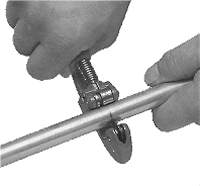Cutting copper pipe
When installing a new run of copper pipe, cut the required lengths of pipe and assemble them into the connectors before making any joints.
This allows any cutting errors to be detected and small adjustments made fairly easily, this will avoid wasted effort and materials.
After cutting copper pipe it is important that:
- The pieces of pipe are all of the correct length
- The circular profile of the pipe is not distorted - even a small amount of distortion can make the pipe unusable
- The end of the pipe is square and clean of burrs.
How to make the cut
It is possible to use a fine hack saw to cut copper pipe but care is required to avoid distortion of the pipe profile.
Using a hack saw imposed a flattening pressure onto the top of the pipe and if excessive force is used the pipe can easily become distorted.
Special care is necessary with the last few strokes of the saw to avoid the scrap piece twisting away and distort both pieces.
 Better than a hack saw is to use a pipe cutter.
Better than a hack saw is to use a pipe cutter.
There are various designs but they consist of a cutting wheel which can be adjusted with rollers mounted opposite.
Initially the cutter is unwound so that the pipe can be inserted, then the cutter is screwed back so that the wheel sits on the pipe where it needs to be cut.
The tool is then be revolved around the pipe,being tightening after each turn.
This causes the wheel to cuts though the pipe producing a right angle cut.
Points to watch with a pipe cutter:
- Start off carefully and slowly to achieve a cut all around the pipe
- Do not tighten the cutter too quickly as this will distort the pipe
- If the pipe needs to be bent using a bending spring, only use light screw pressure on the cutter to reduce the pipe distortion. Otherwise, distortion at the cut may obstruct the insertion of the bending spring. It is often better to use an end piece of a new length of pipe for making bends as the 'as supplied' end is likely to be distortion free.
The most common faults when using a pipe cutter are:
- A 'screw' path of the cutting blade - if the pipe is not mounted square to the rollers, it is possible for the blade to score a 'screw' path along the pipe. Always take care when fitting the pipe into the cutter, and take the first revolution carefully/slowly to ensure that the blade makes a continuous cut around the circumference of the pipe. Once the first score has been made, the blade is less likely to wonder as there will be a path for the cutter to follow.
- Even distortion of the pipe around the cut - this is caused by excessive tightening of the blade after each revolution. It generally won't matter too much but it will restrict the flow of water along the pipe (possibly causing the pipes to be noisy) and will prevent the insertion of a bending spring into the pipe if necessary.
- Uneven distortion of the pipe - this only happens rarely but copper is so soft that the round profile of the pipe can be distorted into three lobes. This only happens when the cutter has initially been excessively tightened onto the pipe and excessive force has been applied to rotate the cutter. If this happens, the pipe is useless as it won't fit into any connector - the only thing to do is to cut off and discard the distorted section of pipe.
Once the pipe has been cut, clean off any burrs (pieces sticking out) with a small file or emery paper.
